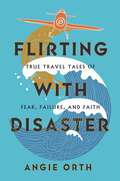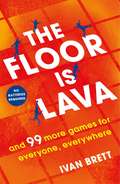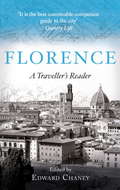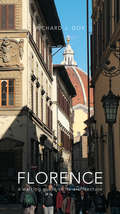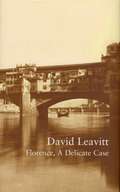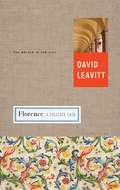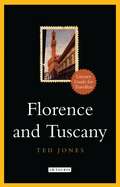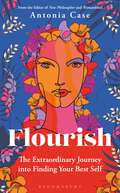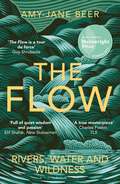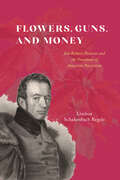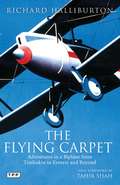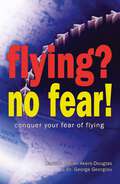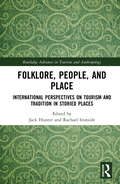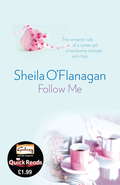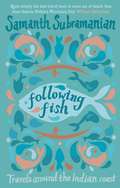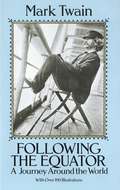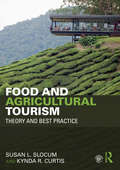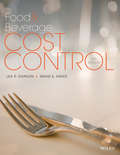- Table View
- List View
Flirting with Disaster: True Travel Tales of Fear, Failure, and Faith
by Angie OrthJoin travel writer Angie Orth on a journey of self-discovery as she empowers readers to buck expectations, take leaps of faith, and trust that God&’s plan is better than anything we think we want for our lives. Angie Orth should have had at least 2.5 kids by now—everyone else back home did. Despite a successful PR career in New York, Angie was failing at the roles she was born to play—those of submissive wife and grandchild incubator. Without a potential husband in sight or the hope of a photogenic brood to show off, she was beginning to wonder if God forgot about her. With her thirtieth birthday looming, Angie was at a crossroads. Should she hightail it home to find a man like a &“good girl&” or continue running the rat race in New York City and hope for the best? Orth chose Plan C: Escape! She quit her job, launched a travel blog, and booked a one-way ticket to the South Pacific while her Southern family gnashed their teeth in protest. But the timing couldn&’t have been worse for a solo trip: she found herself dodging tsunamis, earthquakes, revolutions, grabby men, and incessant DMs from her worrywart relatives over a journey that spanned five continents. In the midst of her global misadventures, Orth&’s hilarious, vulnerable journey of faith and wanderlust demonstrates that God&’s plan is so much more creative than society&’s expectations. Fasten your seatbelt for this sassy, relatable memoir about living life unscripted yet still on mission. By the time readers turn the last page of Flirting with Disaster, they&’ll feel empowered, knowing God&’s vision is better than anything we think we want—or are supposed to want—for our lives. And they&’ll be ready to take on the world in their own way.
The Floor is Lava: and 99 more games for everyone, everywhere
by Ivan BrettPacked with 100 different games, this is a how-to for turning time together into quality time together.Playing games can be so enjoyable but don't you often find yourself playing the same old games time and time again? Well why not let Ivan Brett inspire you with over 99 games to entertain any gathering of friends or family. Put down the phone and pick up the fun. In The Floor is Lava there are games to start a party, ideas to trigger conversation, story-telling setups and fiendish puzzles, plus physical challenges, activities to soothe a weary brain and plenty more. In short, you'll find games for every occasion: * beating boredom in the car* hosting a party* cooling off in the summer holidays* sitting around the dinner table* digesting your Christmas turkey* being trapped indoors on a rainy dayNow, jump up and get started - the floor is lava!You can listen to Ivan's 'The Floor is Lava' weekly podcast on iTunes and Entale.
Florence: A Traveller's Reader
by Edward ChaneyOf all Italian cities, Florence has always had the strongest English accent: the Goncourt brothers in 1855 called it 'ville tout anglaise'. Though that accent is diminished now, Florence remains for the English-speaking traveller what it always has been - one of the best loved, and most visited, of cities.In this Traveller's Reader, Florence's rich and glorious past is brought vividly to life for the tourist of today through the medium of letters, diaries and memoirs of travellers to Florence from past centuries and of the Florentines themselves. The extracts chosen by cultural historain Edward Chaney include: Boccaccio on the Black Death; Vasari on the building of Giotto's Campanile; an eye-witness account of the installation of Michaelangelo's 'David'; the death of Elizabeth Barrett Browning at the Casa Guidi; and D. H. Lawrence and Dylan Thomas on twentieth-century Florentine society. Sir Harold Acton's introduction provides a concise history of the city from its origins, through its zenith as a prosperous city state which, under the Medici, gave birth to the Renaissance, and up to the Arno's devastating flood in 1966. Sir Harold Acton, man of letters, historian, aesthete, novelist and poet, spent most of his life in Florence. Among his best-known books is The Last Medici, Memoirs of an Aesthete.Currently Professor of Fine and Decorative Arts at Southampton Solent University, Edward Chaney is an honorary life member of the British Institute of Florence and taught at the University of Pisa for six years.
Florence: A Walking Guide to Its Architecture
by Richard J. GoyEach year, millions of visitors travel to Florence to admire the architectural marvels of this famous Renaissance city. In this compact yet comprehensive volume, architect and architectural historian Richard J. Goy offers a convenient, accessible guide to the city’s piazzas, palazzos, basilicas, and other architectural points of interest, as well as pertinent historical details regarding Florence’s unique urban environment. Clearly laid out and fully illustrated, this handbook is designed around a series of expertly planned walking tours that encompass not only the city’s most admired architectural sites, but also its lesser-known gems. Maps are tailored to each walking tour and provide additional references and insights, along with introductory chapters on the city’s architectural history, urban design, and building materials and techniques. Featuring a complete bibliography, glossary of key terms, and other useful reference materials, Goy’s guide will appeal both to travelers who desire a greater architectural context and analysis than that offered by a traditional guide and to return visitors looking to rediscover Florence’s most enchanting sites.
Florence: A Delicate Case (The\writer And The City Ser.)
by David Leavitt'Florence is the only European city I can think of whose most famous citizens, at least in the last 150 years or so, have all been foreigners.' Thus David Leavitt writes in this lively account of expatriate life in the city of the lily. His narrative begins by asking why Florence has always proven to be such a popular destination for suicides, then moves into an analysis of what makes the city, in Henry James's words, such a 'delicate case.' Why, for instance, has Florence always drawn so many English and American visitors. (At the turn of the century, the Anglo-American population numbered more than 30,000.) Why have men and women fleeing sex scandal traditionally settled here? What about Florence has made it so fascinating and so repellent - to artists and writers over the years? Moving between present and past, Leavitt's narrative limns the history of the foreign colony from its origins in the middle of the nineteenth century until its demise under Mussolini, and considers the appeal of Florence to figures as diverse as Tchaikovsky, E. M. Forster, Ronald Firbank, Mary McCarthy, Mrs Keppel (mistress to King Edward VII) and Henry Labouchere, author of the Labouchere Amendment, under the provisions of which Oscar Wilde was convicted.
Florence: A Delicate Case (The\writer And The City Ser.)
by David LeavittThe third in the critically acclaimed Writer and the City Series - in which some of the world's finest novelists reveal the secrets of the cities they know best - Florence is a lively account of expatriate life in the 'city of the lily'.Why has Florence always drawn so many English and American visitors? (At the turn of the century, the Anglo-American population numbered more than thirty thousand.) Why have men and women fleeing sex scandals traditionally settled here? What is it about Florence that has made it so fascinating - and so repellent - to artists and writers over the years?Moving fleetly between present and past and exploring characters both real and fictional, Leavitt's narrative limns the history of the foreign colony from its origins in the middle of the nineteenth century until its demise under Mussolini, and considers the appeal of Florence to figures as diverse as Tchaikovsky, E.M. Forster, Ronald Firbank, and Mary McCarthy. Lesser-known episodes in Florentine history - the moving of Michelangelo's David, and the construction of temporary bridges by black American soldiers in the wake of the Second World War - are contrasted with images of Florence today (its vast pizza parlors and tourist culture). Leavitt also examines the city's portrayal in such novels and films as A Room with a View, The Portrait of a Lady and Tea with Mussolini.
Florence and Tuscany: A Literary Guide for Travellers (Literary Guides for Travellers #1)
by Ted JonesThe magical landscapes and rich culture of Tuscany have fostered the inspiration and settings for literature since the works of the great Florentine poets Dante, Petrarch and Boccaccio in the 14th century and has been a magnet for expatriate writers since the arrival in Florence of the English poet Geoffrey Chaucer in 1372. With its historic cities and villages; its verdant countryside and crepuscular coastline; its treasury of art covering five millennia and, above all, its long heritage of authorship, Tuscany one of the most celebrated and well-travelled regions in the world. As the source of the Italian language and birthplace of the Renaissance, Tuscany lies at the historic and cultural heart of Italy, and has remained an irresistible attraction to writers for six centuries. This book is a journey that follows in their footsteps; from John Milton and Thomas Gray to the Brownings, the Shelleys, Charles Dickens, D. H. Lawrence, Thomas Hardy, E. M. Forster, Mark Twain, Muriel Spark and many others. Florence and Tuscany: A Literary Guide for Travellers takes the literary-minded traveller (either in person or in an armchair) on a vivid and illuminating journey, retracing the footsteps of writers who have lived and worked in, or been inspired by, the history and landscape of Tuscany from John Milton and Thomas Gray to the Brownings, the Shelleys, Charles Dickens, D.H. Lawrence, Thomas Hardy, E.M. Forster, Mark Twain Muriel Spark and many others. For anyone who has fallen under a Tuscan spell, as so many have before, this book - the first of its kind - will prove enthralling reading.
Flourish: The Extraordinary Journey Into Finding Your Best Self
by Antonia CaseWhat is a meaningful life? What does it mean to flourish? Antonia Case, the co-founder of New Philosopher and Womankind magazines, quits her corporate job in the city and, with her partner, travels across the world in search of meaning. In a quest to find answers, she turns off the soundtrack of the media, rids herself of technology, and with little more than books as carry-on luggage, she journeys from Buenos Aires to Paris, from Barcelona to Byron Bay, seeking guidance from ancient philosophers and modern-day psychologists on what is a good life, and what is a life worth living. Along the way she discovers why winning the lottery doesn't make you happy, why making is better than having, and how love and belonging are vital to our sense of selves.Packed with insight into life's big questions, Flourish will take you on a riveting journey in search of what matters most.
Flourish: The Extraordinary Journey Into Finding Your Best Self
by Antonia CaseWhat is a meaningful life? What does it mean to flourish? Antonia Case, the co-founder of New Philosopher and Womankind magazines, quits her corporate job in the city and, with her partner, travels across the world in search of meaning. In a quest to find answers, she turns off the soundtrack of the media, rids herself of technology, and with little more than books as carry-on luggage, she journeys from Buenos Aires to Paris, from Barcelona to Byron Bay, seeking guidance from ancient philosophers and modern-day psychologists on what is a good life, and what is a life worth living. Along the way she discovers why winning the lottery doesn't make you happy, why making is better than having, and how love and belonging are vital to our sense of selves.Packed with insight into life's big questions, Flourish will take you on a riveting journey in search of what matters most.
The Flow: Rivers, Water and Wildness
by Amy-Jane BeerA visit to the rapid where she lost a cherished friend unexpectedly reignites Amy-Jane Beer's love of rivers setting her on a journey of natural, cultural and emotional discovery.On New Year's Day 2012, Amy-Jane Beer's beloved friend Kate set out with a group of others to kayak the River Rawthey in Cumbria. Kate never came home, and her death left her devoted family and friends bereft and unmoored. Returning to visit the Rawthey years later, Amy realises how much she misses the connection to the natural world she always felt when on or close to rivers, and so begins a new phase of exploration. The Flow is a book about water, and, like water, it meanders, cascades and percolates through many lives, landscapes and stories. From West Country torrents to Levels and Fens, rocky Welsh canyons, the salmon highways of Scotland and the chalk rivers of the Yorkshire Wolds, Amy-Jane follows springs, streams and rivers to explore tributary themes of wildness and wonder, loss and healing, mythology and history, cyclicity and transformation. Threading together places and voices from across Britain, The Flow is a profound, immersive exploration of our personal and ecological place in nature.
The Flow: Rivers, Water and Wildness
by Amy-Jane BeerA visit to the rapid where she lost a cherished friend unexpectedly reignites Amy-Jane Beer's love of rivers setting her on a journey of natural, cultural and emotional discovery.On New Year's Day 2012, Amy-Jane Beer's beloved friend Kate set out with a group of others to kayak the River Rawthey in Cumbria. Kate never came home, and her death left her devoted family and friends bereft and unmoored. Returning to visit the Rawthey years later, Amy realises how much she misses the connection to the natural world she always felt when on or close to rivers, and so begins a new phase of exploration. The Flow is a book about water, and, like water, it meanders, cascades and percolates through many lives, landscapes and stories. From West Country torrents to Levels and Fens, rocky Welsh canyons, the salmon highways of Scotland and the chalk rivers of the Yorkshire Wolds, Amy-Jane follows springs, streams and rivers to explore tributary themes of wildness and wonder, loss and healing, mythology and history, cyclicity and transformation. Threading together places and voices from across Britain, The Flow is a profound, immersive exploration of our personal and ecological place in nature.
Flowers, Guns, and Money: Joel Roberts Poinsett and the Paradoxes of American Patriotism (American Beginnings, 1500-1900)
by Lindsay Schakenbach RegeleA fascinating historical account of a largely forgotten statesman, who pioneered a form of patriotism that left an indelible mark on the early United States. Joel Roberts Poinsett’s (1779–1851) brand of self-interested patriotism illuminates the paradoxes of the antebellum United States. He was a South Carolina investor and enslaver, a confidant of Andrew Jackson, and a secret agent in South America who fought surreptitiously in Chile’s War for Independence. He was an ambitious Congressman and Secretary of War who oversaw the ignominy of the Trail of Tears and orchestrated America’s longest and costliest war against Native Americans, yet also helped found the Smithsonian. In addition, he was a naturalist, after whom the poinsettia—which he appropriated while he was serving as the first US ambassador to Mexico—is now named. As Lindsay Schakenbach Regele shows in Flowers, Guns, and Money, Poinsett personified a type of patriotism that emerged following the American Revolution, one in which statesmen served the nation by serving themselves, securing economic prosperity and military security while often prioritizing their own ambitions and financial interests. Whether waging war, opposing states’ rights yet supporting slavery, or pushing for agricultural and infrastructural improvements in his native South Carolina, Poinsett consistently acted in his own self-interest. By examining the man and his actions, Schakenbach Regele reveals an America defined by opportunity and violence, freedom and slavery, and nationalism and self-interest.
Flowers, Guns, and Money: Joel Roberts Poinsett and the Paradoxes of American Patriotism (American Beginnings, 1500-1900)
by Lindsay Schakenbach RegeleA fascinating historical account of a largely forgotten statesman, who pioneered a form of patriotism that left an indelible mark on the early United States. Joel Roberts Poinsett’s (1779–1851) brand of self-interested patriotism illuminates the paradoxes of the antebellum United States. He was a South Carolina investor and enslaver, a confidant of Andrew Jackson, and a secret agent in South America who fought surreptitiously in Chile’s War for Independence. He was an ambitious Congressman and Secretary of War who oversaw the ignominy of the Trail of Tears and orchestrated America’s longest and costliest war against Native Americans, yet also helped found the Smithsonian. In addition, he was a naturalist, after whom the poinsettia—which he appropriated while he was serving as the first US ambassador to Mexico—is now named. As Lindsay Schakenbach Regele shows in Flowers, Guns, and Money, Poinsett personified a type of patriotism that emerged following the American Revolution, one in which statesmen served the nation by serving themselves, securing economic prosperity and military security while often prioritizing their own ambitions and financial interests. Whether waging war, opposing states’ rights yet supporting slavery, or pushing for agricultural and infrastructural improvements in his native South Carolina, Poinsett consistently acted in his own self-interest. By examining the man and his actions, Schakenbach Regele reveals an America defined by opportunity and violence, freedom and slavery, and nationalism and self-interest.
The Flying Carpet: Adventures in a Biplane from Timbuktu to Everest and Beyond
by Richard Halliburton"I've just given myself an airplane and I want you to fly us to all the outlandish places in the world, Turkey, Persia, Paris and - Pasadena. We're going to fly across deserts, over mountains, rescue imprisoned princesses and fight dragons. We must have the world. We can have the world!"Thirsting for a new adventure and announcing that 'an adventure not in the air is obsolete', Richard Halliburton hired pioneer aviator Moye Stephens in 1931 and fearlessly set out to circle the world in an open cockpit biplane optimistically named The Flying Carpet. For Halliburton it was the ultimate in romantic, risky exploration and was a means of seeing the world in a way that few had ever seen it before. True to form, his journey was breathtakingly audacious. They performed aerobatics in Fez, landed in mysterious Timbuktu, spent time with the French Foreign Legion in Algeria and explored Cairo, Damascus and Petra. In Iran, they met legendary aviatrix Ella Beinhorn and gave Princess Mahin Banu a ride. In Iraq, it was the turn of King Faisal's young son, Ghazi, who was escorted by two RAF fighter planes. In India, they flew over the Taj Mahal - upside down - and, soaring over the Himalayas, Halliburton took the first aerial photograph of Everest. In Borneo they were entertained by Sylvia Brooke, the 'White Queen of Borneo', and by the chief of the Iban Dyak headhunters, who gave them dozens of shrunken heads. A journey as dazzling as Halliburton himself and, with the world at war less than a decade later, marking the end of an era, the story of The Flying Carpet is as captivating today as it was to the world 80 years ago.
Flying Machines (tactile)
by Adrian FarnsworthThese three pages each show a flying machine. The first is a hot-air balloon with the big round balloon in the centre of the page and the basket hanging down at the bottom of the page. The second page shows two views of an old glider. The front of the glider is to the right and the tail is to the left. There is a plan view at the top of the page and a side view at the bottom. The third page shows an image of an old fashioned aeroplane. It is a top view and the front of the aircraft is to the left and the tail to the right, with the wings going up and down the page.
Flying, No Fear!: Conquer Your Fear of Flying
by Adrian Akers-Douglas George GeorgiouWritten by an airline pilot and a clinical psychologist, this combination of practical explanation and self-help techniques is the definitive guide to help anyone overcome their fear of flying. This new edition incorporates recent advances in technology within the aviation industry, as well as increased security checks as a result of 9/11.
Folklore, People, and Places: International Perspectives on Tourism and Tradition in Storied Places (Routledge Advances in Tourism and Anthropology)
by Jack Hunter Rachael IronsideFolklore, People and Place is a contribution towards better understanding the complex interconnectivity of folklore, people and place, across a range of different cultural and geographical contexts. The book showcases a range of international case studies from different cultural and ecological contexts showing how folklore can and does mediate human relationships with people and place. Folklore has traditionally been connected to place, telling tales of the land and the real and imaginary beings that inhabit storied places. These storytelling traditions and practices have endured in a contemporary world, yet the role and value of folklore to people and places has changed. The book explores a broad range of international perspectives and considers how the relationship between folklore, people, and place has evolved for tourists and indigenous communities. It will showcase a range of international case studies from different cultural and ecological contexts showing how folklore can and does mediate human relationships with people and place. By exploring folklore in the context of tourism, this book engages in a critical discussion of the opportunities and challenges of using storied places in destination development. The case studies in the book provide an international perspective on the contemporary value of folklore to people and places engendering reflection on the role of folklore in sustainable tourism strategies. This book will be of interest to students, academics, researchers in fields such as anthropology, folklore, tourism, religious studies, human geography and related disciplines. It will also be of interest to scholars and practitioners of traditional ecological knowledge.
Folklore, People, and Places: International Perspectives on Tourism and Tradition in Storied Places (Routledge Advances in Tourism and Anthropology)
by Jack Hunter Rachael IronsideFolklore, People and Place is a contribution towards better understanding the complex interconnectivity of folklore, people and place, across a range of different cultural and geographical contexts. The book showcases a range of international case studies from different cultural and ecological contexts showing how folklore can and does mediate human relationships with people and place. Folklore has traditionally been connected to place, telling tales of the land and the real and imaginary beings that inhabit storied places. These storytelling traditions and practices have endured in a contemporary world, yet the role and value of folklore to people and places has changed. The book explores a broad range of international perspectives and considers how the relationship between folklore, people, and place has evolved for tourists and indigenous communities. It will showcase a range of international case studies from different cultural and ecological contexts showing how folklore can and does mediate human relationships with people and place. By exploring folklore in the context of tourism, this book engages in a critical discussion of the opportunities and challenges of using storied places in destination development. The case studies in the book provide an international perspective on the contemporary value of folklore to people and places engendering reflection on the role of folklore in sustainable tourism strategies. This book will be of interest to students, academics, researchers in fields such as anthropology, folklore, tourism, religious studies, human geography and related disciplines. It will also be of interest to scholars and practitioners of traditional ecological knowledge.
Follow Me: Treat yourself to a short and satisfying love story
by Sheila O'FlanaganFOLLOW ME is a fabulously warm, witty and romantic novella from the No. 1 bestselling author Sheila O'Flanagan.Pippa Jones seems to have it all. The only thing that the high-flying career girl is missing is love. When she spots a gorgeous man who seems to be following her everywhere she goes, she wonders if fate is trying to throw them together. But with her job on the line can she afford to make time for this handsome, mysterious stranger?
Following Fish: Travels Around the Indian Coast
by Samanth SubramanianShortlisted for the André Simon Food and Drink book awardsIn a coastline as long and diverse as India's, fish inhabit the heart of many worlds - food of course, but also culture, commerce, sport, history and society. Journeying along the edges of the peninsula, Samanth Subramanian delivers a kaleidoscope of extraordinary stories.Following Fish conducts rich journalistic investigations of, among others, the use of fish to treat asthmatics in Hyderabad; of the preparation and the process of eating West Bengal's prized hilsa; of the ancient art of building fishing boats in Gujarat; of the fiery cuisine and the singular spirit of Kerala's toddy shops; of the food and the lives of Mumbai's first peoples; of the history of an old Catholic fishing community in Tamil Nadu; and of the hunt for the world's fastest fish near Goa.Pulsating with pleasure, adventure and discovery, and tempered by nostalgia and loss, Following Fish reveals a series of unknown Indias in a book as revealing of the subcontinent as any three times its length.
Following the Equator: A Journey Around the World
by Mark TwainSo begins this classic piece of travel writing, brimming with Twain's celebrated brand of ironic, tongue-in-cheek humor. Written just before the turn of the century, the book recounts a lecture tour in which he circumnavigated the globe via steamship, including stops at the Hawaiian Islands, Australia, Fiji Islands, New Zealand, India, South Africa and elsewhere.View the world through the eyes of the celebrated author as he describes a rich range of experiences — visiting a leper colony in Hawaii, shark fishing in Australia, tiger hunting, diamond mining in South Africa, and riding the rails in India, an activity Twain enjoyed immensely as suggested by this description of a steep descent in a hand-car: "The road fell sharply down in front of us and went corkscrewing in and out around the crags and precipices, down, down, forever down, suggesting nothing so exactly or so uncomfortably as a crooked toboggan slide with no end to it. . . . I had previously had but one sensation like the shock of that departure, and that was the gaspy shock that took my breath away the first time that I was discharged from the summit of a toboggan slide. But in both instances the sensation was pleasurable — intensely so; it was a sudden and immense exaltation, a mixed ecstasy of deadly fright and unimaginable joy. I believe that this combination makes the perfection of human delight."A wealth of similarly revealing observations enhances this account, along with perceptive descriptions and discussions of people, climate, flora and fauna, indigenous cultures, religion, customs, politics, food, and many other topics. Despite its jocular tone, this book has a serious thread running through it, recording Twain's observations of the mistreatments and miseries of mankind. Enhanced by over 190 illustrations, including 173 photographs, this paperback edition — the only one avai1able — will be welcomed by all admirers of Mark Twain or classic travel books.
Food and Agricultural Tourism: Theory and Best Practice
by Susan L. Slocum Kynda R. CurtisThis book fills a gap in the growing academic discipline of food and agricultural tourism, offering the first multidisciplinary approach to food tourism and the role it plays in economic development, destination marketing, and gastronomic exploration. It provides a comprehensive introduction to the discipline by considering food tourism in connection with both cultural values and important issues in agriculture, food consumption and safety, and rural heritage and sustainability. The book is divided into four Parts. Part I defines the elements of food tourism and explains its relationship with sustainability. Part II provides an overview of rural development and demonstrates the impact of industrialization and globalization on eating habits. Part III focuses on food tourism studies and market segmentation techniques to help students understand customer needs regarding food tourism products. Finally, Part IV looks at the financial, policy, and legal requirements relating to food tourism development, providing hands-on tools for students entering food tourism businesses or industries. Complemented by a wide range of international case studies, key definitions, and study questions, Food and Agricultural Tourism is essential reading for students of tourism, geography, and economic development studies.
Food and Agricultural Tourism: Theory and Best Practice
by Susan L. Slocum Kynda R. CurtisThis book fills a gap in the growing academic discipline of food and agricultural tourism, offering the first multidisciplinary approach to food tourism and the role it plays in economic development, destination marketing, and gastronomic exploration. It provides a comprehensive introduction to the discipline by considering food tourism in connection with both cultural values and important issues in agriculture, food consumption and safety, and rural heritage and sustainability. The book is divided into four Parts. Part I defines the elements of food tourism and explains its relationship with sustainability. Part II provides an overview of rural development and demonstrates the impact of industrialization and globalization on eating habits. Part III focuses on food tourism studies and market segmentation techniques to help students understand customer needs regarding food tourism products. Finally, Part IV looks at the financial, policy, and legal requirements relating to food tourism development, providing hands-on tools for students entering food tourism businesses or industries. Complemented by a wide range of international case studies, key definitions, and study questions, Food and Agricultural Tourism is essential reading for students of tourism, geography, and economic development studies.
Food and Beverage Cost Control
by Lea R. Dopson David K. HayesThis fully updated sixth edition of Food and Beverage Cost Control provides students and managers with a wealth of comprehensive resources and the specific tools they need to keep costs low and profit margins high. In order for foodservice managers to control costs effectively, they must have a firm grasp of accounting, marketing, and legal issues, as well as an understanding of food and beverage sanitation, production, and service methods.
